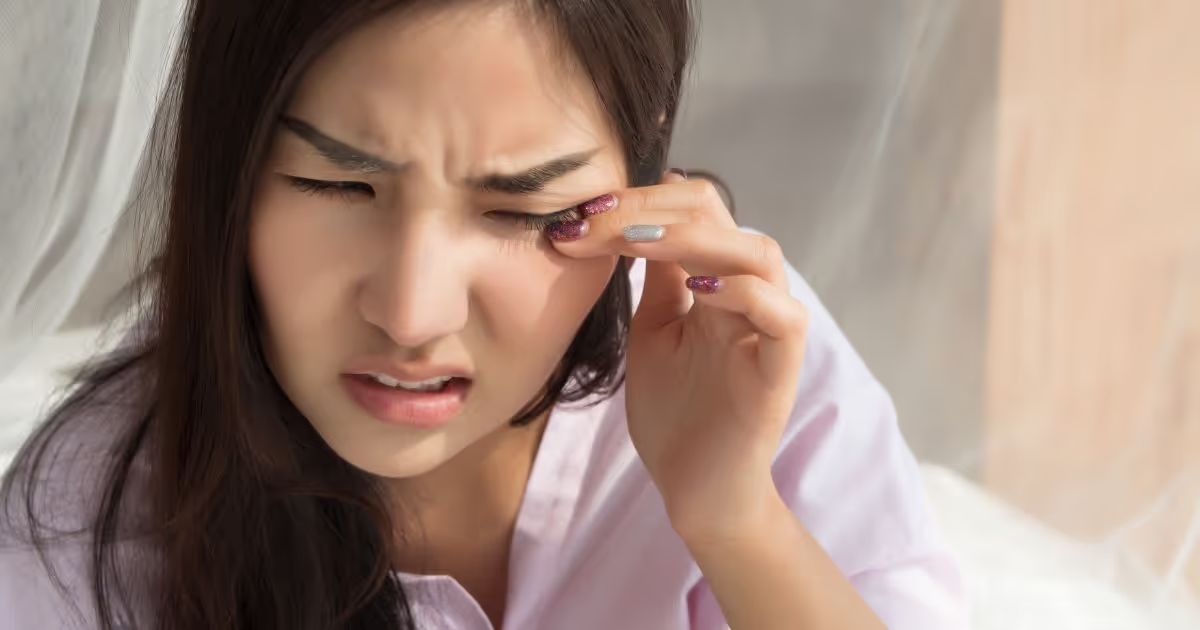Choose the topic you want to read.
- Allergic conjunctivitis symptoms
- Allergic conjunctivitis Causes
- Diagnosis of allergic conjunctivitis
- How to treat allergic conjunctivitis
- Home remedies
- Prevention of eye allergies
Allergic conjunctivitis
Allergic conjunctivitis occurs when the conjunctiva, the transparent membrane protecting your eyes, is irritated by allergens such as dust mites, pollen, or mold spores. This irritation often leads to symptoms like redness, itchiness, and excessive tearing, characteristic of allergic conjunctivitis.
Types of allergic conjunctivitis
- Acute allergic conjunctivitis: When you encounter an allergen such as cat dander, you can develop this type of conjunctivitis. Your eyes become severely red, itchy, watery, and swollen, but they can go away within 24 hours after the allergen is no longer present.
- Seasonal allergic conjunctivitis (SAC): This eye allergy causes mild but persistent symptoms during the pollen season.
- Perennial allergic conjunctivitis (PAC): The symptoms of perennial allergic conjunctivitis can develop year-round, triggered by indoor allergens, e.g., dust mites, animal dander, and molds.
Symptoms
- Itchiness, redness, swelling, and tearing of the eyes and eyelids.
- Burning and gritty sensation in the eyes
- Light sensitivity
Causes
Allergic conjunctivitis occurs when your body's defense mechanism reacts to perceived threats and triggers the release of histamine to combat foreign invaders such as:
- Dust in your home
- Tree or grass pollen
- Spores of mold
- Animal dander
- Household volatile chemicals such as perfume or detergent
Diagnosis
History taking and eye exam. Your doctor will ask you about your allergy history and examine your eyes. If you have signs of allergic conjunctivitis, the doctor may order additional tests.
- Skin prick test
The test can determine to which allergen you are allergic. - Blood test
This test can determine if you have developed antibodies against allergens such as mold and dust. - Conjunctival Scraping
To examine the presence of activated eosinophils, which are white blood cells associated with allergic reactions, a doctor may collect a sample of your conjunctival tissue by gentle scraping, allowing for further examination and analysis of the white blood cells.
Treatment
Medications
There are several types of eye drops available for managing allergic conjunctivitis, including:
- Antihistamine eye drops reduce or block histamine release.
- Prescription allergy eye drops, such as Olopatadine, Ketotifen, or Epinastine, for alleviating allergy symptoms.
- Anti-inflammatory eye drops.
- Eye drops shrink congested blood vessels in the eyes to relieve eye redness.
- Steroid eye drops for severe inflammation.
Before using eye drops, consult your doctor to determine the most appropriate eye drops for your specific condition.
Home remedies
- Do not rub your eyes, as it can aggravate your symptoms.
- Use artificial tears or eye drops to rinse your eyes to relieve itchiness.
- Apply a cold compress to the affected area to alleviate inflammation and discomfort.
- Protect yourself from pollen by wearing a hat and sunglasses when going out. Take a shower after coming home.
- Wash your hands before touching your eyes.
Prevention
To prevent allergic conjunctivitis -- the most effective approach is to minimize exposure to environmental triggers. Although this can be challenging, the following measures may be helpful:
- Install an air purifier at home.
- Utilize scent-free soaps and detergents.
- Regularly clean or vacuum your house to reduce allergens.
- Limit the presence of carpets, soft toys, curtains, and soft furnishings in your home. They can accumulate allergens to which you are allergic.
Allergic Conjunctivitis VS Pink Eye
Allergic conjunctivitis results from exposure to allergens, causing symptoms including itching, redness, and tearing in both eyes simultaneously. Avoiding the known triggers can help prevent allergic reactions.
Due to a viral infection, conjunctivitis is called pink eye, typically begins in one eye and then spreads to the other. It can cause intense itching of the eyes and is highly contagious.










